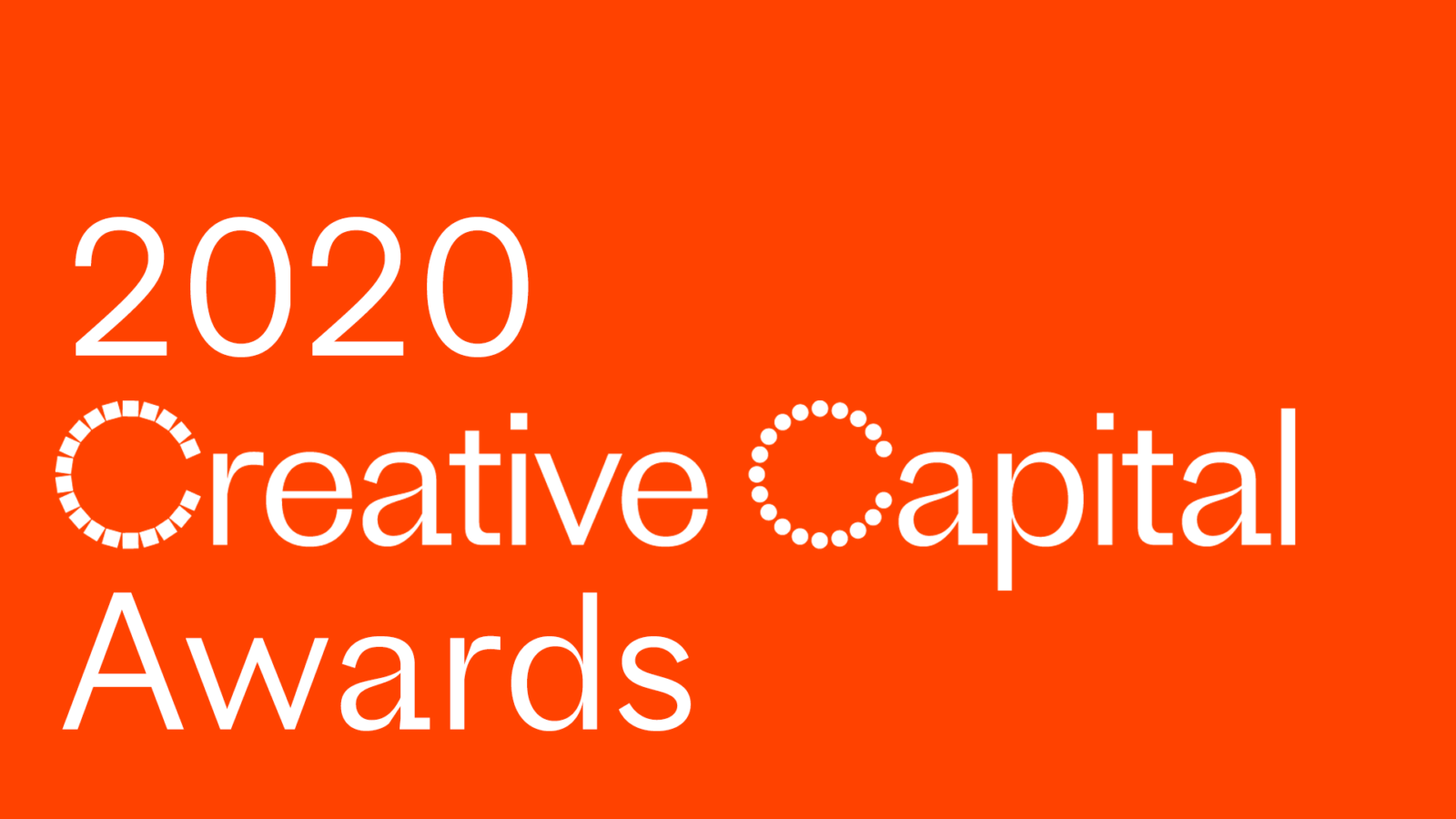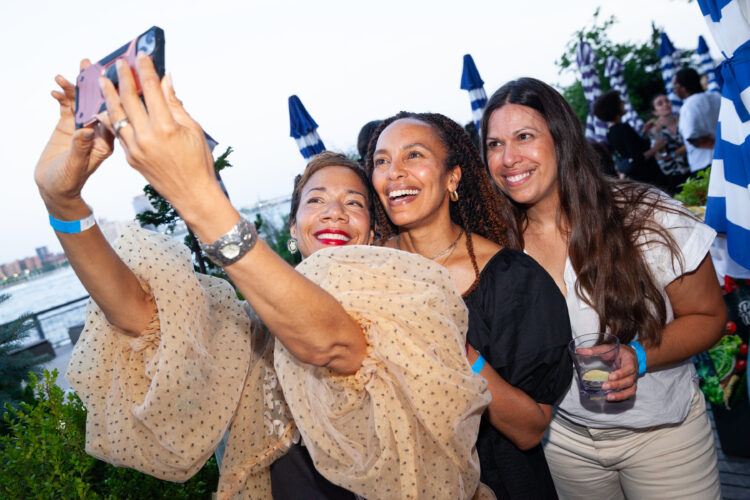How We Selected the 2020 Creative Capital Awards

Every year, thousands of US artists submit their projects for consideration to receive a Creative Capital Award. It’s a competitive process that takes time and thoughtfulness, so it’s something we take very seriously. After the application closes, we ask about a hundred reviewers working in all fields of the arts across the country to evaluate them. These reviewers consider a range of criteria, such as boldness and originality of the project ideas, and the artists’ capacity and readiness to make use of our unique support.
After a multiphase process, a small number of projects proceed to a final, in-person panel—consisting of professionals and artists whose expertise span all artistic disciplines—gathering for a two-day discussion. Creative Capital encourages intention and care in the consideration of these projects mirroring the support artists who receive the award benefit from. “It’s a daunting process—especially when you’re looking at so many applications from across a broad range of disciplines,” said panelist Gina Duncan, “but when you come across an application that is unique, deeply-considered, and clear in its perspective and intent, it makes the work of the panel heartening.”
The panel’s final selection of 35 projects by 41 artists make up the 2020 Creative Capital Awards.
See the 2020 Creative Capital Awards
Final Round Panelists
- Cassils | Creative Capital Awardee; Artist
- Ken Chen | Executive Director, Asian American Writers’ Workshop
- Gina Duncan | Vice President, Film and Strategic Programming, Brooklyn Academy of Music
- Carlos Gutiérrez | Executive Director, Cinema Tropical
- Angela Mattox | Performing Arts Curator; Former Artistic Director, PICA
- Laleh Mehran | Creative Capital Awardee; Professor of Emergent Digital Practices at University of Denver
- Roderick Schrock | Executive Director, Eyebeam
- Stacy Switzer | Curator and Executive Director, Fathomers
- Tara Aisha Willis | Associate Curator of Performance, MCA Chicago
“What makes this award special,” said Cassils, “is that it supports art for art’s sake—for the value of what culture can do for us as a society. It gives US-based artists the important chance to pursue their work separate from the demands of the market.”
The Process
With so many project proposals, reviewers have a unique opportunity to analyze a dataset of work being made today. Artists are responding to the world’s most pressing issues, using cutting edge technologies—sometimes even building new tools—and developing new strategies to engage their audiences. “The sheer number of proposals, reflecting such a diverse range of artistic viewpoints is nothing short of astounding,” said Angela Mattox, “It gives me great confidence in the groundswell of artistic imagination, vision, and rigour emanating from diverse geographies around the country.”
Creative Capital was founded after the National Endowment for the Arts balked at funding controversial, risky, and avant-garde art projects during the “culture wars” of the ’90s. Artists that trouble the status quo and take risks with their work are therefore a core component of our mission —though they aren’t the only kinds of projects we fund. Cassils, panelist and artist who received the Creative Capital Award in 2015, noted how important it is to support artists who are making this kind of “risky, difficult, political” work. “What makes this award special,” said Cassils, “is that it supports art for art’s sake—for the value of what culture can do for us as a society. It gives US-based artists the important chance to pursue their work separate from the demands of the market.”
However, risk-taking work isn’t always easy to identify through a written application as Stacy Switzer noted: “I think it’s important that we give a second and third look to projects that aren’t always conceptually tidy and buttoned up,” she said. “Sometimes, projects can be so thoroughly considered that they appear, even in the proposal stage, as a kind of beautiful, balanced equation.” Switzer adds that she would “encourage artists to keep proposing projects that really push the boundaries of their own practices—and aspire to move culture in significant ways.” “Whether its formal innovation or subverting process or industry,” added Mattox, for Creative Capital, “experimentation is really embraced at the core.”
Challenging, Insightful Work
This was only the second year of an interdisciplinary review process for the Creative Capital Award—both allowing artists in all disciplines to apply, and bringing together panelists in all fields to consider the work. “I was pleased to see a variety of perspectives at the table,” said Cassils. “This mirrored the diversity of disciplines, approaches, and subjectivities of the artist applicants.” It was a rare chance for arts professionals to speak across sectors. Noting that “there are big barriers between the different artistic practices,” Carlos Gutierrez said “it’s a very healthy process to compare notes between the different artistic disciplines.” This cross-sector discussion was more than just healthy for the arts field in general, Gutierrez added—”the multidisciplinary aspect of the panel actually allows for new ways to rethink the work of the artist in a larger context beyond its artistic discipline.”
Discussing interdisciplinary work that is still in progress, projects whose end result is not fully in sight, proved for rich and generative grounds for conversation. “I most enjoyed discussing ‘difficult’ projects,” said Switzer, “projects where, for example, the framework for social engagement is still under construction; where the ideas are evolving, or are even potentially quite problematic.” Reviewers appreciated that Creative Capital pushed the panel to take chances on artists unknown to them, and pay specific attention to work that generated tough conversations, whether it provoked, confounded, or problematized.
In the end, Creative Capital strives to give the same time and thoughtfulness in consideration of the artists and their work as the artists put into their applications. Projects in early stages of research and development can be personal, intimate, important, and critical. “I am incredibly impressed by the care, rigor, and hard work put into the process,” said Roderick Schrock. “These conversations are vital to maintaining a complex landscape of ideas inside and outside the art world,” added Switzer.
Insights from the Field
As a survey of work being made for tomorrow’s consumption, the Creative Capital Award application provides a unique insight into what concerns artists today. Many applications propose work in uncharted territory, especially when it comes to new technologies. Schrock said that he “was thrilled to see the emerging media and technology practitioners whose work made it to the final rounds, and highly impressed that Creative Capital is reaching those types of practitioners, working in areas that sometimes feel parallel but non-intersectional to more established fields.”
Identity, trauma, and healing were big issues, and given the times we are living in, perhaps not surprising. “There was a lot of work which dealt with healing,” Cassils noted. “A lot of didactic work which reflect the polarized times.” Mattox added that she was “struck by the volume of applications delving into complexities around identity, as well as a vast amount of applications that addressed themes of resilience, survival, and response to trauma and oppression. Many of the proposals were deeply personal and intimate, while simultaneously in relationship to broader socio-political realities.”
Artists provide a way forward, helping us see through particularly troubling moments in history. Laleh Mehran, Creative Capital Awardee and panelist in this cycle said that the “urgency of pressing current issues were very much present in the applications—including the Anthropocene, environment, and immigration.” Artistic activism was just one way that artists are tackling important civic and political issues. “I was pleased by the serious activist work being done by so many of the applicants,” said Schrock. “It was striking, to engage with this work in the review process, and a reminder of the vitality and necessity for artists to be publicly vocal and engaged with the wider world.”
What makes the announcement of the Creative Capital Awards unique is that these artists are just in the beginning stages of their projects. As we partner with them over the next years, we are excited to see what possibilities lie ahead for the artists, for the contemporary art landscape, and how the arts will affect our future. “There is a deep authenticity, care, and support in the Creative Capital Award,” said Mehran, “which makes the relationship unique and lasting.”
The Full List of Reviewers
Jasmine Amussen, Burnaway; Amara Antilla, Guggenheim Museum; Jessica Anthony, writer, Creative Capital Awardee; Steve Bailey, National Performance Network; Eric Banks, NYU; Maria Bauman-Morales, MBDance; Madeline Bell, Flynn Center; Makeda Best, Harvard Art Museums; Bianca Beyrouti, ITVS; Clint Bowie, New Orleans Film Society; Loris Bradley, Loris Creative Productions; Claire Breukel, YES Contemporary; Heidi Broadhead, Wave Poetry; Alrick Brown, NYU; Victoria Camblin, 032c; Mario Caro, MIT; Sophie Cavoulacos, MOMA; Robert Y. Chang, American Documentary; C. Ondine Chavoya, Williams College; Solana Chehtman, The Shed; Erin Christovale, Hammer Museum; Deb Clapp, League of Chicago Theatres; Michael Connor, Rhizome; Charlotte Cook, Field of Vision; Liz Cook Mowe, Kickstarter; Nerissa Cooney, Mana Contemporary; Dean Daderko, CAM Houston; Samantha De Tillio, Museum of Arts and Design; Carl Deal, elsewhere films; Makeba Dixon-Hill, Spelman College Museum of Art; Sonia Epstein, Museum of the Moving Image; Amber Esseiva, ICA VCU; Elizabeth Ferrer, BRIC; Courtenay Finn, moCa Cleveland; Novella Ford, Schomburg Center; Sylvie Fortin, Bemis Center; Lisa Gedgaudas, Create Denver; Sarah Greenbaum, Dance Place; Sonia Guiñansaca, CultureStrike; Casandra Hernandez, CALA Alliance; Stefanie Hessler, TBA21 London; Megan Heuer, Whitney Museum; Marcus Hu, Strand Releasing; Hitomi Iwasaki, Queens Museum; Marjon Javadi, Doc Society; Stephanie Jeter, Searching Productions; Curtis John, The Luminal Theater; Jeffrey Johnson, University of Kentucky School of Architecture; Ladi’Sasha Jones, The Laundromat Project; Jane Jung, Ping Chong & Co.; Kristan Kennedy, PICA; Benjamin Kimitch, Performance Space New York; Melanie Kress, Friends of the High Line; Jennifer Lange, Wexner Center; Jordana Leigh, Lincoln Center; Andrew Mer, BigFuss; Jocelyn Miller, MOMA PS1; Lucy Mukerjee, Tribeca Film Festival; Diana Nawi, Prospect New Orleans; Kelani Nichole, TRANSFER Gallery; Sara O’Keeffe, New Museum; Meg Onli, ICA Philadelphia; Sara Ortiz, Black Mountain Institute; Kendra Patrick, Gallery Kendra Jayne Patrick; Sheetal Prajapati, Lohar Projects; Ben Pryor, Kelly Strayhorn Theater; Chris Reitz, Hite Art Institute; Jonathan Rider, FLAG Art Foundation; Michael Rooks, The High Museum of Art; Saidah Russell, Jacob Burns Film Center; Joshua Sanchez, filmmaker; Bently Spang, artist, Creative Capital Awardee; Shawn Sides, Rude Mechs, Creative Capital Awardee; Tony Stone, Heathen Films; Leslie Tamaribuchi, Tamaribuchi HMC; Claire Tancons, curator; Tashima Thomas, Pratt Institute; Stephanie Todd Wong, Asia Society Texas Center; Sean Uyehara, Headlands Center for the Arts; Ivan Velez, artist, Creative Capital Awardee; Angelik Vizcarrondo-Laboy, Museum of Arts and Design; Wolfgang Wachalovsky, Mugwumpin; Jasmine Wahi, Project for Empty Space; Chloe Walters Wallace, Firelight Media; Ella Watson, School of Art at Montana State University; Michael Wiegers, Copper Canyon Press; Stephanie Ybarra, Baltimore Center Stage; Joey Yates, KMAC Museum; Jessica Fallon Young, New Orleans Film Society; Natalia Zuluaga, NAME Publications
See the 2020 Creative Capital Awards. The next application for the Creative Capital Awards opens to artists in all disciplines February 1-29, 2021. Sign up for our newsletter to receive the latest updates, and prepare in advance by reading every question we ask on the application.
